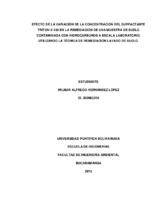Efecto de la variación de la concentración del surfactante triton X-100 en la remediación de una muestra de suelo contaminada con hidrocarburos a escala laboratorio, utilizando la técnica lavado de remediación lavado de suelo
Fecha
2014-09-10Director/Asesor
Muskus Morales, Angélica María
Tipo de contenido
bacherlorThesis
Citación
Metadatos
Mostrar el registro completo del ítemDocumentos PDF
Resumen
Ante la necesidad de implementar acciones que ayuden a recuperar los suelos contaminados por hidrocarburos en nuestro país, el Instituto Colombiano de Petróleos junto con la Universidad Pontificia Bolivariana, incentivaron este proyecto investigativo enfocado a la remediación de suelos contaminados con Hidrocarburos. La metodología desarrollada en este proyecto, fue dividida en cuatro fases direccionadas al cumplimiento de los objetivos específicos y general del mismo, teniendo así los fundamentos correctos para dar un paso en el proceso de remediación de un predio afectado por derrames de hidrocarburos, perteneciente a la empresa ECOPETROL S.A. Inicialmente se realizó un estudio detallado del área de influencia directa e indirecta del proyecto y de actividades relacionadas con la recuperación de la zona contaminada, con el fin diagnosticar la zona de estudio. Para la segunda fase del proyecto se realizó la caracterización fisicoquímica del suelo contaminado, con la cual se conoció el impacto negativo que ocasiona la contaminación por hidrocarburos sobre el suelo de Campo Palagua. Las condiciones de diseño y operación para la aplicación de la técnica de remediación, fueron determinadas en la tercera fase, al igual que las condiciones para el uso del surfactante; teniendo como resultado, un sistema en columna de dimensiones 40 cm de altura y 10 cm de diámetro, con flujo ascendente de solución de lavado a caudal de 0.5 ml/min y cuatro concentraciones de surfactante Tritón X-100, las cuales se establecieron en 1, 2, 4 y 6 veces la Concentración Micelar Critica. Pasados los cuatro meses de lavado, se realizó el análisis final del proyecto y se concluyó que, la concentración de surfactante más eficiente en la remoción de hidrocarburos fue la de 4 veces la CMC, ya que se encontró menos cantidad de contaminación en la solución de lavado de la columna trabajada a 6 veces la CMC; logrando identificar la concentración de 1000 ppm como la más óptima para remover hidrocarburos en suelos contaminados. Given the need to take measures to help restore soils contaminated by oil in our country, the Instituto Colombiano de Petróleos (Colombian Institute of Petroleoum) together with the Universidad Pontificia Bolivariana (Pontificia Bolivariana University), encouraged this research project focused on the remediation of soils contaminated with hydrocarbons. The methodology developed in this project was divided into four phases routed to the fulfillment of the specific and general objectives of the project, having in this way the right foundations to step in the process of remediation of a piece of land affected by oil spills that belong to the Ecopetrol company. Initially, a detailed study of the area of direct and indirect influence of the project and activities related to the recovery of the contaminated area was carried out in order to diagnose the study area. For the second phase of the project the physicochemical characterization of this contaminated soil was done, which revealed the negative impact that is caused by hydrocarbons on the soil of the Campo Palagua area. The design and operating conditions for the implementation of the remediation technique were determined during the third stage, the same as the conditions for the use of the surfactant, obtaining as a result, a column system of dimensions 40 cm height and 10 cm in diameter, with an upward flow of washing solution at a flow rate of 0.5 ml / min and four concentrations of surfactant, which were set to 1, 2, 4 and 6 times the CMC. After four months of washing, the final analysis of the project was carried out and it was concluded that the most efficient concentration of surfactant in the removal of hydrocarbons was the 4 times the CMC, as it was found less contamination in the washing solution of the column worked at 6 times the CMC. and succeeded in identifying the concentration of 1000 ppm as the most optimal for removing hydrocarbons in contaminated soils.
Palabra/s clave
Ingeniería ambiental
Contaminación de suelos
Suelos
Hidrocarburos
Fisicoquímica
Empresas - Ecopetrol S.A
Colecciones
- Trabajos de grado [6688]


